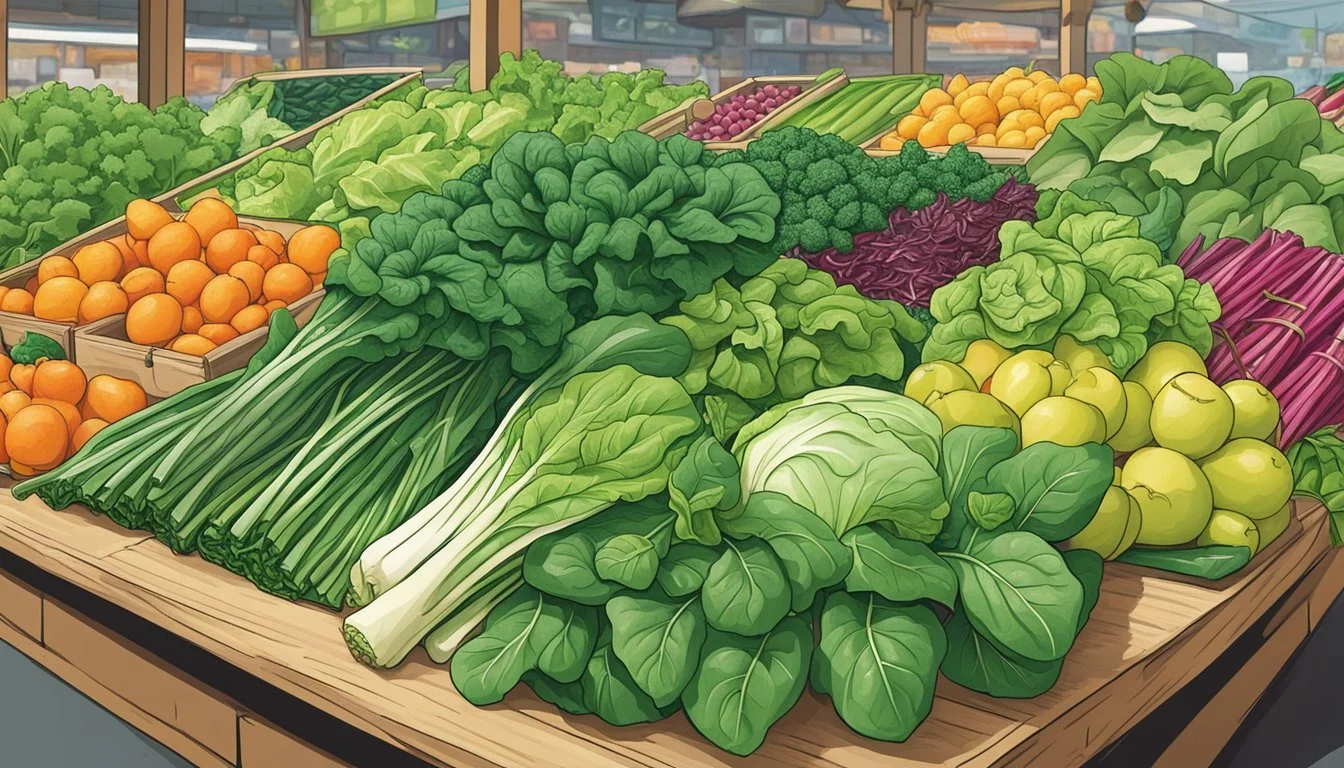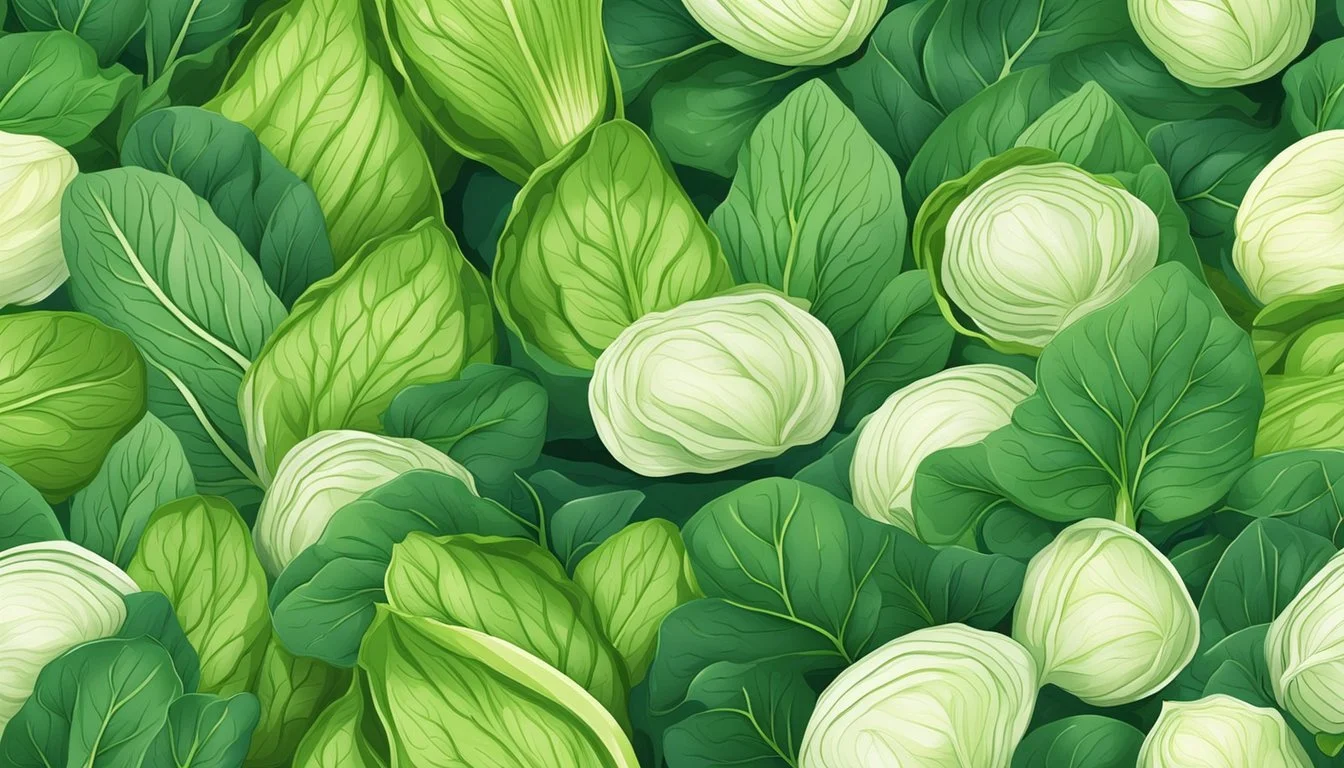Komatsuna Substitutes
Top Alternatives for Your Recipes
Komatsuna, also known as Japanese mustard spinach or Brassica rapa var. perviridis, is a versatile and nutritious leafy green often featured in Japanese cuisine. This superfood, rich in calcium and vitamins, can be stir-fried, pickled, boiled, or added to soups and salads. However, it might not always be readily available outside of Japan, prompting the need for suitable substitutes.
Spinach stands out as one of the best alternatives to komatsuna, offering a similar texture and nutrient profile. Swiss chard, napa cabbage, and mizuna are also good replacements, each bringing a slightly different taste and texture to dishes. These substitutes can readily fit into recipes like stir-fries, salads, and soups without compromising the nutritional and culinary benefits.
When using these substitutes, slight adjustments in cooking times or methods might be necessary to achieve the desired result. For instance, spinach blanches quickly, while swiss chard may require a bit more time to become tender. By understanding these differences, one can easily incorporate these greens and enjoy the nutritious benefits that komatsuna provides.
Understanding Komatsuna
Komatsuna, a leafy green vegetable from Japan, is part of the Brassica family. It is favored for its versatility in cooking and its rich nutritional profile.
Cultivation and Seasonality
Komatsuna thrives in cool weather conditions. It can be grown year-round in Japan, with peak seasons in spring and fall. Farmers typically cultivate it in well-drained, fertile soil and ensure consistent moisture levels.
The plant matures quickly, usually within 30 to 40 days from planting. Its resilience to cold allows it to withstand light frosts, making it a reliable crop for various climatic conditions.
Nutritional Profile
Komatsuna is highly nutritious, offering a range of vitamins and minerals. It is particularly rich in vitamin C, vitamin A, and calcium.
A 100-gram serving provides a substantial amount of dietary fiber and is low in calories. Additionally, as a member of the Brassica family, it contains glucosinolates, which are compounds believed to have health-promoting properties.
Culinary Uses
Komatsuna’s mild flavor and tender texture make it a versatile ingredient in many dishes. It can be used fresh in salads or cooked in various recipes such as stir-fries, soups, and nimono (simmered dishes).
To maintain its nutrients and texture, it’s often recommended to cook Komatsuna lightly. It pairs well with both Asian and Western flavors, making it a flexible choice for fusion cuisine.
Popular Komatsuna Substitutes
Various substitutes for komatsuna can replicate its taste and texture in different dishes like salads, stir-fries, and soups. Some of the most suitable alternatives include spinach, bok choy, and Swiss chard, which offer similar nutritional benefits and culinary versatility.
Spinach: A Versatile Substitute
Spinach stands out as a widely accessible and nutrient-rich alternative to komatsuna. Spinach has a mild flavor and similar texture that works well in salads and cooked dishes.
Containing high levels of vitamins A and C, iron, and calcium, it boosts the nutritional profile of any meal. It adapts well to diverse cooking methods, whether fresh in salads, wilted into soups, or added to stir-fries. Its versatility makes it a staple substitute in many kitchens.
Bok Choy: Similar Texture and Flavor
Bok choy is another excellent substitute, providing a similar texture and flavor to komatsuna.
It has crisp stalks and tender leaves that are suitable for a variety of dishes, from raw salads to cooked dishes like stir-fries and soups. Bok choy is rich in vitamins C and K, offering substantial health benefits. Its mild, slightly sweet flavor complements a range of ingredients, making it a versatile option for replacing komatsuna in your recipes.
Swiss Chard: Colorful and Nutrient-Rich
Swiss chard not only replaces komatsuna effectively but also adds a splash of color to any dish.
This leafy green is packed with nutrients like vitamins A and K, magnesium, and iron. Its slightly bitter taste mellows with cooking, making it suitable for salads, soups, and stir-fries. The colorful stems and vibrant leaves enhance the visual appeal of meals, making it a visually pleasing substitute for komatsuna. Swiss chard's ability to absorb flavors well makes it a preferred choice among many cooks.
Assessing Substitute Suitability
When assessing substitutes for komatsuna, key factors include taste profiles, texture and cooking properties, as well as nutritional content.
Taste and Flavor Profiles
Komatsuna has a mild flavor, slightly peppery, and subtly sweet. Suitable substitutes should mimic these characteristics. Baby spinach is a popular alternative, offering a similar mildness. Swiss chard also works; it brings a slightly earthy taste while maintaining mildness. Boy choy provides a subtle bitterness that can add complexity to dishes, giving a balance close to komatsuna.
Texture and Cooking Behaviors
Komatsuna has tender leaves and crisp stems. Baby bok choy mirrors this texture well, especially when stir-fried or steamed. Napa cabbage can also be a substitute; its leaves are tender, and it retains a crisp texture upon cooking. Swiss chard offers a robust texture that holds up well in soups and sautés, providing versatility similar to komatsuna.
Nutritional Equivalence
Komatsuna is rich in vitamins A, C, and K. Spinach is highly nutritious, matching komatsuna in terms of vitamin A and iron content. Kale is another substitute with high nutritional value, especially vitamin K and antioxidants. Bok choy offers comparable levels of vitamins A and C, making it a strong nutritional substitute. Deciding on the nutritional adequacy of substitutes ensures balanced and healthful meals.
Recipe Adaptations with Substitutes
When substituting komatsuna in recipes, different methods are used for raw dishes compared to hot dishes. Each approach ensures the dishes remain flavorful and nutritious.
Preparing Substitutes for Raw Dishes
For salads and other fresh recipes, spinach is a common alternative to komatsuna. Its similar texture and mild taste make it an ideal substitute. When preparing spinach, wash it thoroughly to remove any dirt or grit.
Baby kale is another suitable substitute. It's slightly more bitter, so adjust seasoning to balance the flavors.
Arugula can provide a peppery kick. It pairs well in dishes that benefit from its strong flavor. Use it sparingly to avoid overpowering the dish.
Cooking with Substitutes in Hot Dishes
In stir-fries and soups, spinach and bok choy are effective stand-ins for komatsuna. Both hold up well under heat without becoming mushy.
When using spinach in hot dishes, add it towards the end of cooking to retain its texture. Bok choy, with its thicker stems, can be added earlier in the cooking process.
Collard greens are a heartier option. They require longer cooking times to soften. Slice them thin for faster cooking. Always ensure these substitutes absorb flavors well by simmering them in broths or sauces.
Using these substitutes ensures a variety of flavors and textures while maintaining the integrity and taste of the original recipes.
Storing Substitutes for Freshness
Keeping substitutes for komatsuna fresh involves proper storage techniques. Utilizing the refrigerator and freezer correctly can extend the life of these leafy vegetables.
Refrigerator Tips for Leafy Vegetables
To preserve leafy vegetable substitutes in the refrigerator, store them in an airtight container. This helps maintain humidity and keeps them crisp.
Refrigeration at temperatures between 32-36°F (0-2°C) is ideal. Ensure the vegetables are dry before storage to prevent rotting. Wrap the leaves in a damp paper towel before placing them in the container, as this can help maintain moisture balance.
When storing, keep the vegetables away from fruits like apples and bananas, which emit ethylene gas that can accelerate spoilage.
Freezing Techniques for Longer Shelf Life
For longer shelf life, freezing is an effective method. First, clean and blanch the leafy vegetable substitutes in boiling water for 1-2 minutes, then quickly transfer them to an ice bath to halt the cooking process.
Drain and pat the vegetables dry. Portion them into freezer-safe bags or containers. Removing as much air as possible helps prevent freezer burn.
Label each container with the date before placing in the freezer. Frozen leafy vegetables can typically last for several months, maintaining their nutritional value and flavor when properly stored.
By following these techniques, you can ensure your leafy vegetable substitutes remain fresh and ready for use.
Enhancing Dishes with Komatsuna
Komatsuna, also known as Japanese mustard spinach, is a versatile leafy green that can elevate various dishes with its light, slightly peppery flavor. Whether included in salads, stir-fries, traditional Japanese meals, or homemade dressings and condiments, it adds a nutritious and delicious element to any cuisine.
Incorporating into Salads and Stir-Fries
Komatsuna works exceptionally well in both raw and cooked dishes. When added to salads, its crisp texture contributes to a refreshing bite. Pair it with other vegetables like daikon, cucumber, and tomatoes for a nutritionally dense, colorful salad.
In stir-fries, the green adds a tasty crunch. Quickly sauté it with garlic and soy sauce for a simple yet flavorful side dish. The leaves retain their light texture, making them a perfect complement to proteins like chicken or tofu.
Creation of Traditional Japanese Dishes
Komatsuna plays a significant role in many traditional Japanese dishes. In nabe (Japanese hot pot), it enhances the umami flavors of the dashi broth. Adding komatsuna towards the end of cooking preserves its texture and nutrients.
It is also favored in Japanese pickles, offering a crisp and flavorful element. Komatsuna can be pickled with ingredients such as miso, soy sauce, and vinegar to create light yet flavorsome accompaniments to rice and main dishes.
Homemade Dressings and Condiments
Creating dressings and condiments at home can be easily done with komatsuna. Blending it into sauces adds a nutritious green element. A komatsuna and garlic dressing pairs beautifully with meats and vegetables, providing a vibrant and healthy enhancement.
Combining finely chopped komatsuna with soy sauce, mirin, and sesame oil results in a versatile dressing that can be drizzled over salads or used as a marinade. This approach brings a delicious Japanese twist to everyday meals, highlighting the green's adaptability and culinary merit.
Health Benefits of Komatsuna Substitutes
Various substitutes for komatsuna, such as spinach and kale, not only replicate its culinary flexibility but also provide significant nutritional benefits. These alternatives are packed with essential vitamins, minerals, and dietary fiber, making them excellent choices for different diets and health requirements.
Vitamins and Minerals Content
Substitutes like spinach and kale are rich in vitamins and minerals. Spinach is known for its high content of vitamins A and C, iron, and calcium. Per serving, spinach offers approximately 2813 IU of vitamin A and 28 mg of vitamin C. Kale is another nutritious choice that provides substantial amounts of vitamins K, A, and C, alongside potassium and magnesium. Kale contains 547 mcg of vitamin K, 206% DV of vitamin A, and more than 100% DV of vitamin C per serving. These nutrients support various bodily functions, including immune health and bone strength.
Dietary Fiber and Its Advantages
Including leafy greens like spinach and kale in your diet promotes a high intake of dietary fiber. Spinach contains around 2.2 grams of fiber per 100 grams, aiding digestion and maintaining a healthy gut. Kale offers about 2 grams of fiber per cup, which helps regulate blood sugar levels and supports weight management. Dietary fiber is crucial for preventing constipation and reducing the risk of chronic diseases such as heart disease and diabetes.
Special Diets Consideration
Komatsuna substitutes such as spinach and kale fit well into various special diets. Both vegetables are ideal for vegan and vegetarian diets, providing essential nutrients often lacking in plant-based diets, such as iron and protein. They are also considered superfoods due to their high nutrient density. For those on calorie-restricted or low-carb diets, both greens are excellent choices because they are low in calories yet high in nutrients. Moreover, the high calcium content in kale makes it beneficial for lactose-intolerant individuals who need alternative sources of this essential mineral.
Purchasing and Price Considerations
When selecting a substitute for komatsuna, it's important to consider factors such as market availability and cost. Analysing these aspects helps in making an informed decision.
Market Availability of Substitutes
Substitutes like spinach, bok choy, and Swiss chard are widely available in most markets. Spinach is especially common and can be found year-round in supermarkets. Bok choy is prevalent in Asian markets and many grocery stores. Swiss chard is also available but may be more seasonal, peaking in availability during spring and summer.
The market season for each vegetable affects its availability and price. For instance, bok choy may be more accessible in late summer and fall. Farmers' markets often feature a variety of leafy greens, offering an excellent opportunity to find fresh alternatives to komatsuna.
Cost Comparison with Komatsuna
The cost of substitutes often varies depending on several factors, including seasonality and demand. Spinach is generally affordable and can usually be purchased for less than $2 per bunch. Bok choy is slightly more expensive, typically ranging from $2 to $3 per pound. Swiss chard costs about the same as bok choy, though prices can rise during off-peak seasons.
Komatsuna itself is usually affordable but may be more expensive outside of Asian specialty stores. Comparing costs helps in selecting a budget-friendly option without compromising nutritional value. Spinach, being rich in vitamins A and C, provides a cost-effective, nutritious alternative to komatsuna. Bok choy and Swiss chard also offer excellent nutrition, albeit at a slightly higher cost.
Culinary Inspirations from Around the World
Komatsuna is a versatile vegetable that can be substituted with various leafy greens in an array of global cuisines. Whether you are inspired by Asian culinary traditions or Western cuisine, there are numerous options to explore.
Asian-Inspired Dishes with Substitutes
For those who relish Asian cooking, vegetables like mizuna, pak choi, and Chinese cabbage provide excellent alternatives to komatsuna. These substitutes can be used in stir-fries, soups, and salads. For example, mizuna, with its peppery taste, complements ramen and sushi rolls. Pak choi can replace komatsuna in Japanese recipes like nimono or shabu-shabu, offering a similar crunch and freshness.
Western Cuisine Adaptations
In Western cuisine, spinach and kale serve as superb replacements for komatsuna. Both are packed with nutrients and can be used in dishes like quiches, omelets, and salads. Spinach’s mild flavor blends well in pasta dishes and lasagna, providing a subtle yet nutritious addition. Kale, with its robust texture, can be incorporated into hearty soups and stews, ensuring that the dish remains satisfying and flavorful.
Fusion Cooking Ideas
Fusion cooking opens up endless possibilities for integrating komatsuna substitutes. Pair tatsoi with European ingredients to create unique salads or side dishes. Tatsoi’s delicate flavor harmonizes with cheeses and nuts, making it perfect for fusion cuisine. Additionally, try blending mizuna in smoothies or using pak choi in Mediterranean-style stews. These creative combinations celebrate the versatility of these leafy greens while bridging culinary traditions from around the world.









